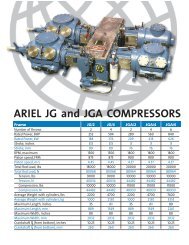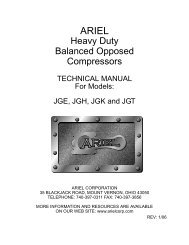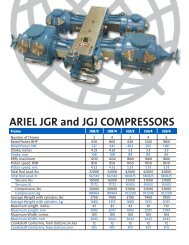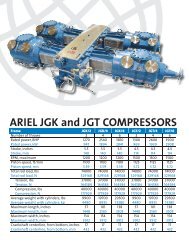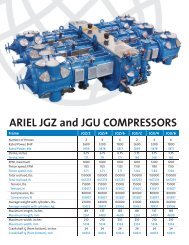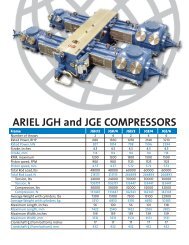Heavy Duty Balanced Opposed Compressors
Heavy Duty Balanced Opposed Compressors
Heavy Duty Balanced Opposed Compressors
You also want an ePaper? Increase the reach of your titles
YUMPU automatically turns print PDFs into web optimized ePapers that Google loves.
FOR MODELS: JG AND JGA SECTION 5 - MAINTENANCE<br />
vertical and horizontal directions. When measuring vertical rod moment, upward movement<br />
will be recorded as positive, downward movement will be recorded as negative. When measuring<br />
horizontal rod movement, rod movement toward the auxiliary end of the frame, will be<br />
recorded as a positive reading, movement toward the drive end of the frame will be recorded<br />
as a negative reading. Copy Table 5-2 to record readings. Bar over crankshaft by hand and<br />
record readings at mid-stroke and with piston at the head end.<br />
TABLE 5-2: PISTON ROD RUN OUT<br />
VERTICAL<br />
HORIZONAL<br />
THROW NUMBER: 1 2 3 4 5 6<br />
Compare readings to Table 5-3.<br />
Piston @ CE<br />
Mid-Stroke<br />
Piston @ HE<br />
0 0 0 0 0 0<br />
Piston @ CE<br />
Mid-Stroke<br />
Piston @ HE<br />
0 0 0 0 0 0<br />
TABLE 5-3: MAXIMUM ACCEPTABLE PISTON ROD RUN OUT READINGS<br />
DIRECTION<br />
JG & JGA<br />
INCHES (mm)<br />
Vertical 0.0010 (0.025)<br />
Horizontal 0.0005 (0.013)<br />
If a vertical reading is greater than the maximum acceptable reading, the following procedure<br />
is used to determine acceptability: With the piston at the head end, use feeler gages to<br />
determine clearance at the top of the piston. On wear band pistons this clearance is over the<br />
band. Feeler top clearance is divided by ()) 2 and then the following amount is subtracted:<br />
(-)0.003 inches (0.08 mm). Place a feeler of this calculated thickness under the bottom of<br />
the piston. Place the feeler under the wear band on wear band pistons. This feeler should be<br />
long enough to stay under the piston as the piston is moved throughout its stroke. Re-measure<br />
vertical run out and compare to acceptable limits in the table above. The horizontal<br />
readings, taken without the use of feelers are to be used for acceptance. Copy Table 5-4<br />
and record calculations and readings.<br />
TABLE 5-4: FEELER THICKNESS TO CORRECT FOR PISTON WEIGHT<br />
LINE THROW NUMBER: 1 2 3 4 5 6<br />
1 Top Feeler Clearance<br />
2 Line 1 ()2)<br />
3 Line 2 - 0.003” (-0.08 mm) - 0.003” (-0.08 mm)<br />
4 Bottom Feeler Thickness<br />
5 Vertical~Piston @ CE 0 0 0 0 0 0<br />
6 Vertical~Piston @ HE<br />
PAGE 5 - 22 11/01





